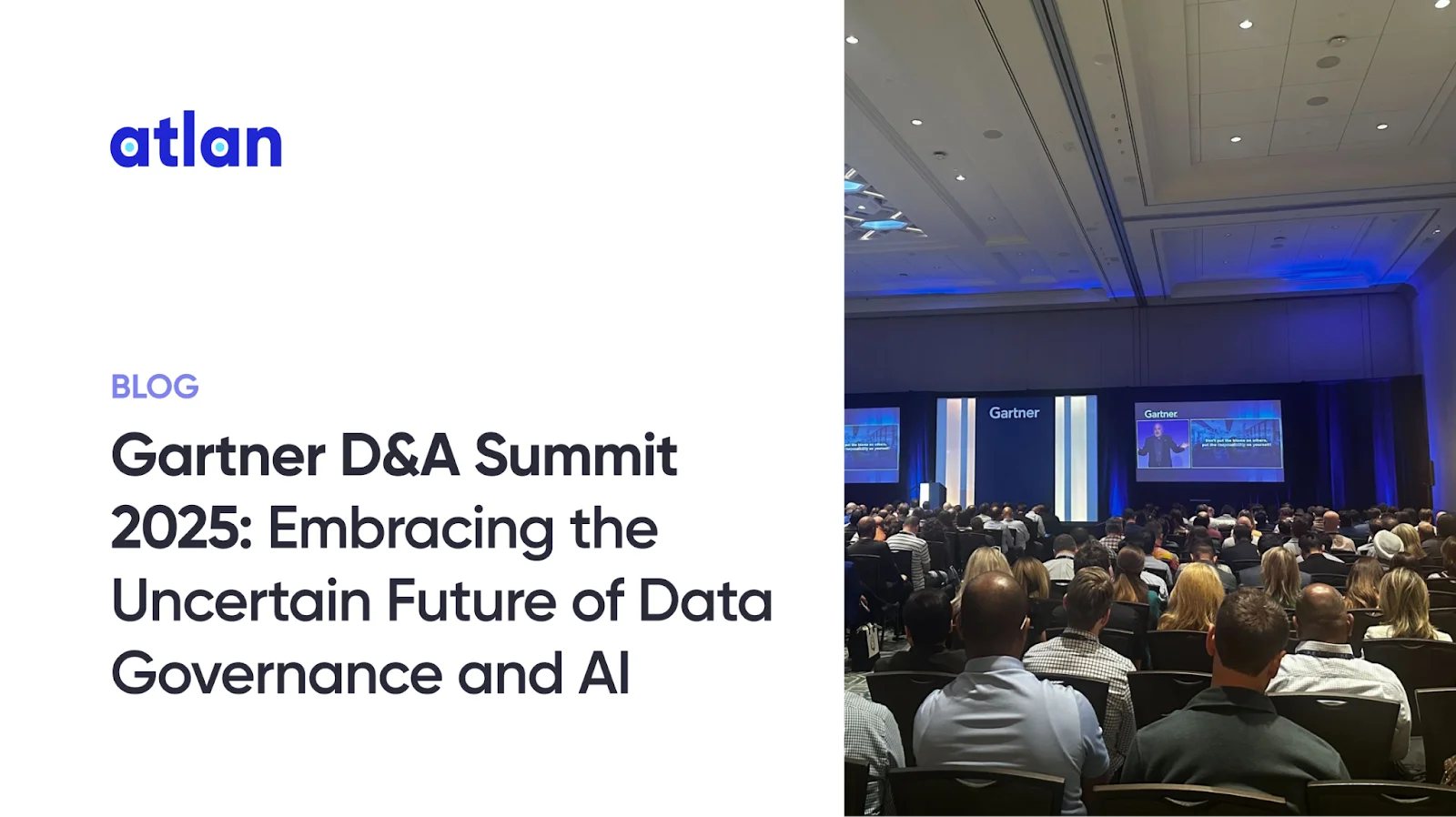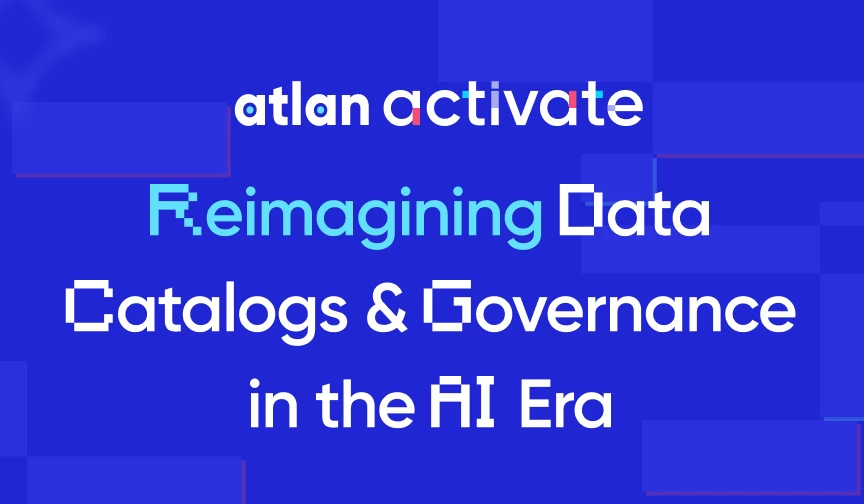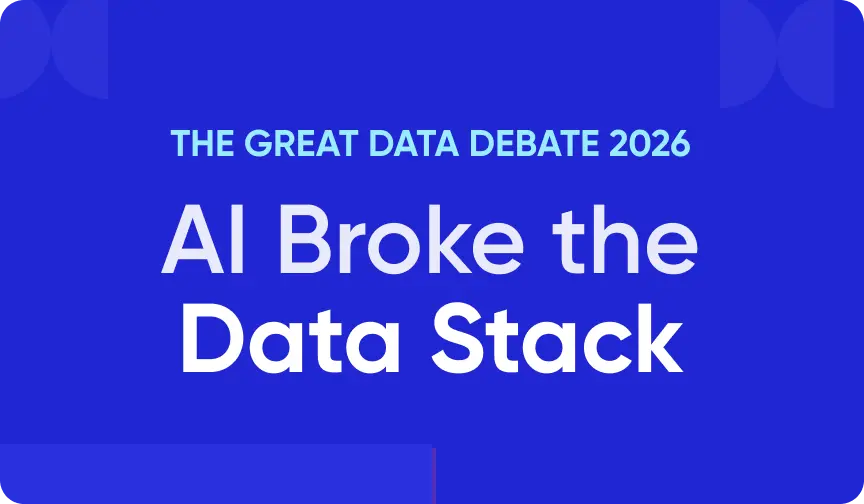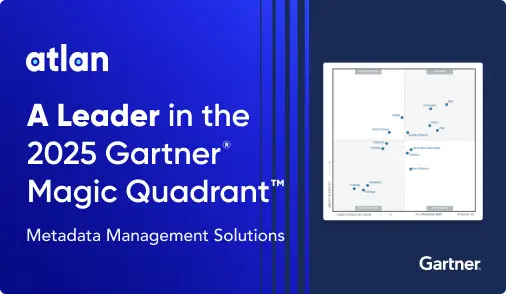Data Leaders in the Trenches Agree: Governance Is the AI Multiplier

Last Updated on: April 11th, 2025 | 6 min read
Unlock Your Data's Potential With Atlan


Data governance has vaulted to the top of every data leader’s agenda in 2025, and with good reason. Organizations everywhere want to leverage AI at a broader, faster pace. Yet trust, compliance, and context have never been more crucial. Whether the focus is generative AI, predictive analytics, or data-driven decision-making, the conversation inevitably returns to one question: Is our data governed well enough to support this?
The recent industry gathering, Gartner’s Data and Analytics Summit, reinforced this central theme. Insights from real-world sessions, like General Motors’ approach to operationalizing governance and Medtronic’s domain-based operating model, provide a clear picture of why data governance is so pivotal. Not only does it accelerate AI deployments, but it also safeguards quality, compliance, and collaboration along the way.
Below are five major insights we gathered fueling data governance discussions right now, along with examples of how they are playing out. Each one highlights why governance is no longer a “nice to have” but an urgent priority.
AI Is Turning Governance into a Business Imperative
Permalink to “AI Is Turning Governance into a Business Imperative”Large language models and copilots don’t fail because of weak algorithms, they fail because they lack context and trust. In the AI-native era, governance isn’t a gatekeeper, but the engine that embeds trust directly into the systems powering modern decisions. To scale AI safely and effectively, organizations must move beyond checklists and static rules to governance that is intelligent, embedded, and real-time.
Gartner insights:
- In “AI Governance: Design an Effective AI Governance Operating Model,” Gartner Analyst Svetlana Sicular warned that ignoring data governance can lead to both legal and reputational fallout. She presented case studies of ungoverned AI models that produced biased results, ultimately triggering internal and external investigations.
- Gartner Analyst Sumit Agarwal’s “Technical Insights: A Technical View of AI Governance” reiterated that “AI readiness of data” (lineage, versioning, privacy) is a must-have, not a luxury, for advanced analytics to work.
Shifting Left: Governance as Part of Design, Not Just Deployment
Permalink to “Shifting Left: Governance as Part of Design, Not Just Deployment”Tacking on data governance at the tail end of a project can stall final approvals or uncover compliance gaps far too late. “Shift left” means weaving in stewardship, lineage checks, and policy alignment right from the start.
Gartner insights:
- General Motors showcased how each new data product is tagged with ownership and usage policies upfront. By the time those assets feed into AI pipelines, no one is scrambling to confirm if the data is secure or accurate.
- During “Technical Insights: A Technical View of AI Governance,” Sumit Agarwal noted that building lineage into an MLOps architecture at an early stage cuts rework significantly. MLOps or “machine learning operations” streamlines how models are developed, deployed, and maintained. Because the process can be complex, addressing data curation, labeling, and documentation up front prevents nasty compliance surprises later on.
Domain Models Are the Future: Decentralize with Clear Ownership
Permalink to “Domain Models Are the Future: Decentralize with Clear Ownership”Centralized governance structures often lead to bottlenecks and frustrated business units. An emerging best practice is to create distinct “domains” (Finance, Supply Chain, Marketing, etc.) each with its own governance rules, data owners, and stewards.
Gartner insights:
- Medtronic shared how domain-centric structures boosted data catalog adoption. Local stewards took ownership, so employees knew whom to contact with questions. This reduced the “Which team owns this data?” confusion and accelerated cross-functional use.
- Svetlana Sicular’s “AI Governance: Design an Effective AI Governance Operating Model” stressed that domain autonomy aligns governance with each function’s maturity, scope, and risks. You avoid a one-size-fits-all approach that rarely suits every business area.
Automation Alone Isn’t Enough, Human Oversight Remains Critical
Permalink to “Automation Alone Isn’t Enough, Human Oversight Remains Critical”AI is supercharging governance: generative AI tools can label data, propose policies, or spot anomalies far quicker than human teams. Yet, people are still vital in the loop, no AI can fully grasp company-specific nuances or ethical boundaries on its own.
Gartner insights:
- GM reported automating lineage discovery and classification but requiring domain stewards to validate critical details. A flagged column might appear sensitive, yet only a human steward can confirm it actually holds personal data.
- Another reminder came from Gartner Analyst Melody Chien’s session, “Unstructured Data Quality: How to Improve Trust to Ensure AI-Ready Data,” where she emphasized that ensuring AI-readiness for unstructured data, like PDFs, emails, and text files, requires more than automation. Chien explained that while tools can assist with parsing and organizing this data, human judgment is essential to detect content drift, flag outdated or misleading information, and ensure continued relevance. She illustrated the point with the example of the discredited 1981 study falsely linking autism to vaccines, noting how legacy content like this can persist in enterprise systems and poison AI outcomes if not carefully governed. It’s a powerful case for why governance processes must include human oversight, especially when the data in question isn’t structured, simple, or static
Value Realization: Proving Governance Delivers Real ROI
Permalink to “Value Realization: Proving Governance Delivers Real ROI”Even with AI’s hype, C-level executives want to know how governance affects productivity and bottom-line results. The answer typically comes in fewer compliance fiascos, less time wasted searching for the right dataset, and more reliable AI outputs.
Gartner insights:
- Medtronic’s internal survey revealed that data workers were spending up to five and a half hours each week searching for information. And three hours of that just trying to find data. By implementing domain-based stewardship and clearer certification in their data catalog, they aimed to significantly reduce this friction, especially in high-impact areas like supply chain and finance.
- Gartner Analyst Stephen Kennedy pointed out in “AI for Data Governance” that organizations with robust governance can enable automated self-service for their business users, speeding up data exploration without introducing chaos. Reduced friction means faster time-to-value for new AI projects.
Where to Go from Here
Permalink to “Where to Go from Here”Across all these insights, whether shifting left, embracing domain models, or balancing AI automation with human judgment, the message in 2025 is clear: governance done right is a catalyst, not a blocker. Organizations that make governance a priority are seeing faster AI deployments, fewer compliance surprises, and greater overall trust in data-driven insights.
For teams ready to take the next step, it helps to have a platform that simplifies domain-based structures, automates repetitive stewardship tasks, and keeps governance processes transparent. That’s where Atlan fits in. Developed by data teams for data teams, Atlan creates a seamless experience for discovering, cataloging, classifying, and governing data across domains. Organizations like GM and Medtronic have showcased how easy it is to integrate Atlan into modern data stacks, from cloud warehouses to BI tools, without piling on extra overhead.
All signs point to data governance remaining center stage—especially as AI ambitions grow. By adopting these best practices and anchoring them in a modern, embedded governance framework, data leaders can close the trust gap and scale AI with confidence.
Want to see what intelligent, embedded governance actually looks like in the AI-native era?
Permalink to “Want to see what intelligent, embedded governance actually looks like in the AI-native era?”Book a personalized demo to see Atlan in action—or bring your team to one of our bi-weekly live demos and explore how the Metadata Lakehouse powers trusted data, copilots, and decisions across your stack.
Share this article
Atlan is the next-generation platform for data and AI governance. It is a control plane that stitches together a business's disparate data infrastructure, cataloging and enriching data with business context and security.





















